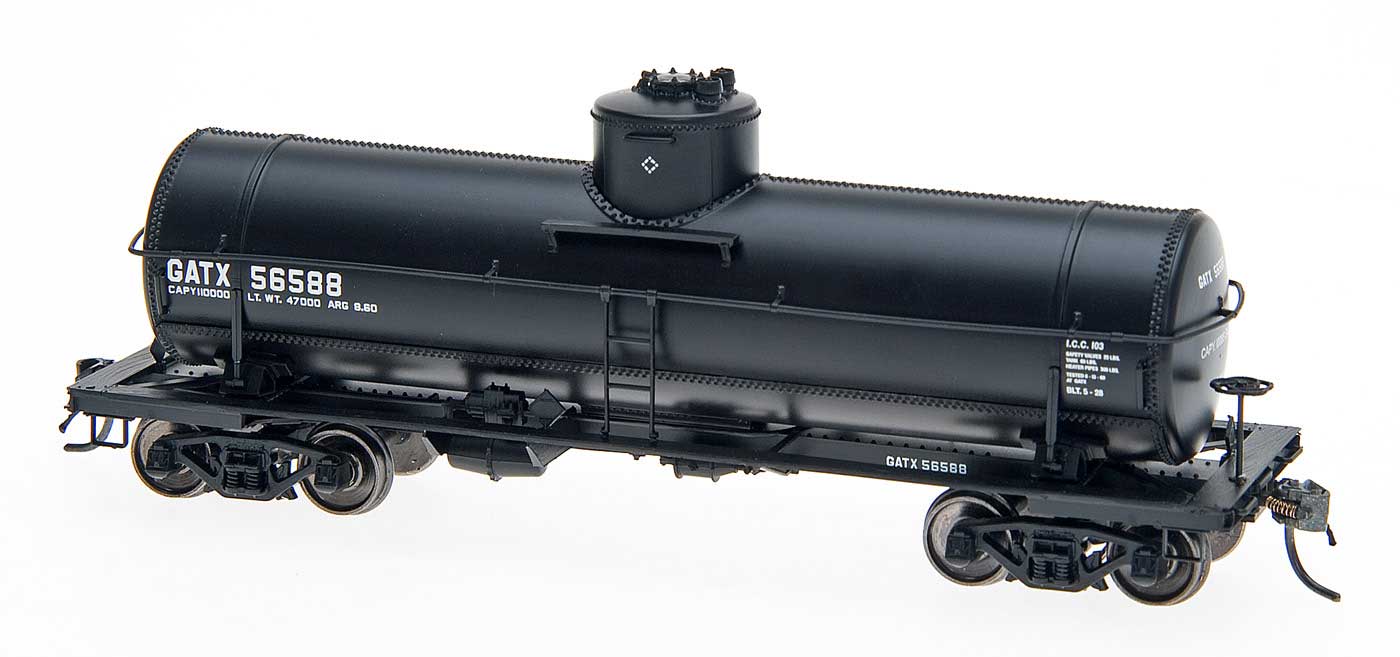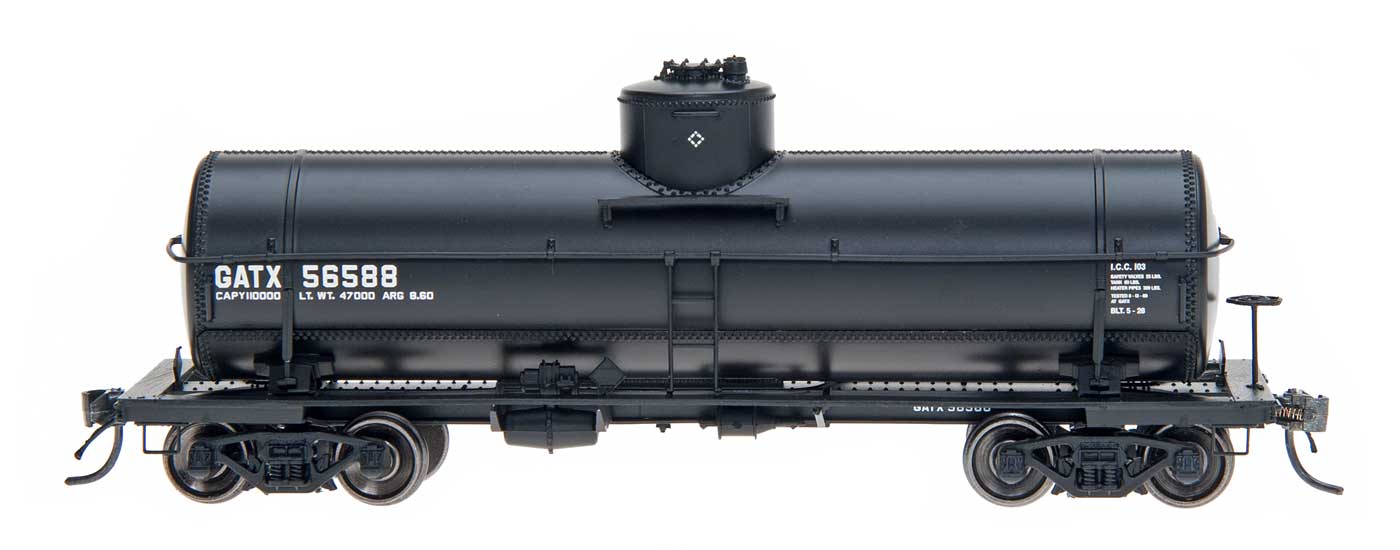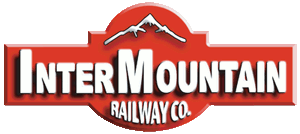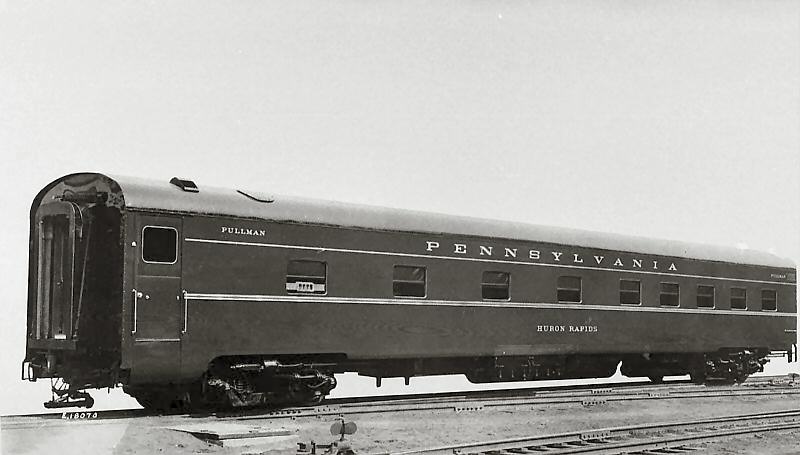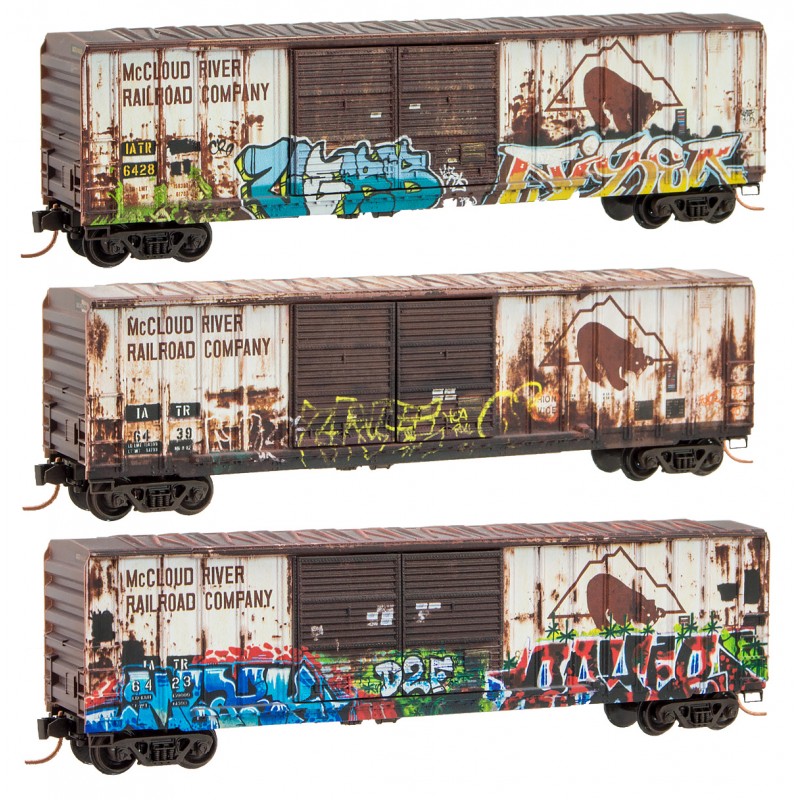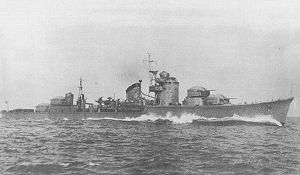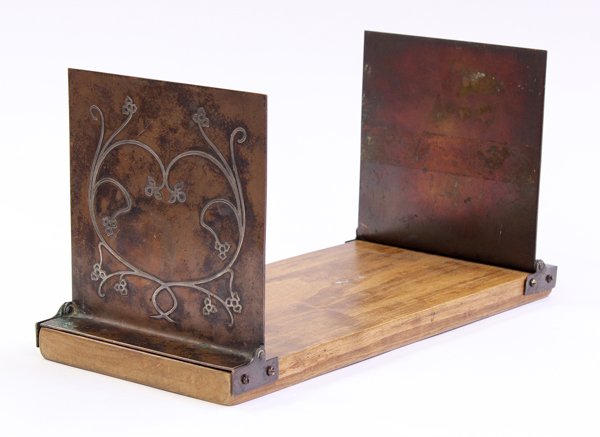General Information About Item: Built: ARG 8-60
Body Style Information:
- Laser Sharp Painting and Printing
- 33" InterMountain Metal Wheelsets
- Metal Knuckle Couplers
- Minimum Radius - 18"
- Laser Sharp Painting and Printing
- 33" InterMountain Metal Wheelsets
- Metal Knuckle Couplers
- Minimum Radius - 18"
Prototype Information: Single Dome tank cars are a railroad staple. They have been around since the first half of the 20th century. This length car can handle about 10,000 gallons. These railcars carry a wide array of commodities, including liquid fertilizers, chemicals, fuel oils and asphalt, and food-grade oils. Tank cars can be pressurized or non-pressurized, insulated or non-insulated. Single dome cars carry only a single commodity at once. Food-service tank cars may be lined with stainless steel, glass, or plastic. Tank cars carrying dangerous goods are generally made of different types of steel, depending on the intended cargo and operating pressure. They may also be lined with rubber or coated with specialized coatings for tank protection or product purity purpose. The tank heads are also stronger to prevent ruptures during accidents.
The 32 foot (190 barrel) tank of the 1890’s was built of quarter-inch steel plate. It followed the usual design of having the inlet orifice at the top of the dome and the outlet valve at the bottom to which connecting lines could be attached for emptying. A car could also be unloaded by siphon from the top, but this wasn t the usual practice. In 1892 there were as many as ten thousand tank cars in use in the United States (Bolles, 1893).
The 32 foot (190 barrel) tank of the 1890’s was built of quarter-inch steel plate. It followed the usual design of having the inlet orifice at the top of the dome and the outlet valve at the bottom to which connecting lines could be attached for emptying. A car could also be unloaded by siphon from the top, but this wasn t the usual practice. In 1892 there were as many as ten thousand tank cars in use in the United States (Bolles, 1893).
Road/Company Information: GATX Corporation (NYSE: GMT) is an equipment finance company based in Chicago, Illinois. Founded in 1898, GATX's primary activities consist of railcar operating leasing in North America and Europe. In addition, GATX leases locomotives in North America, and also has significant investments in industrial equipment. GATX derives its name from its primary reporting mark for its North American railcars, "GATX". The mark itself was derived from GATX's prior corporate name, General American Transportation Corporation. Since all non-railroad owners of railcars must append an "X" to the end of their mark, GAT became GATX. The General American Transportation Corporation became GATX Rail Corporation, a unit of the GATX Corporation, on January 1, 2000.
GATX mainly applies the GATX mark to tank cars, although the mark has been used in other examples such as with hoppers; GATX's primary freight car marks are GACX (for general-service freight cars), GGPX (for coal cars), GIMX (for intermodal cars), GPLX (for plastic pellet cars), GMTX and LLPX (for locomotives), and GPFX (for pressure-differential cars). GATX also owns a number of other marks, including GABX, GAEX, GFSX, GOHX, GSCX, IPSX, and TRIX. Many GATX cars carry a large "GATX" logo in the upper right-hand corner of the car regardless of the reporting mark they carry; this logo is applied for marketing reasons and does not have any operational significance.
GATX engages in both full-service and net leasing of railcars. In a full-service lease, a GATX-owned mark is applied to the car, and GATX maintains the railcar and pays for any required property insurance and property taxes. In a net lease, the lessee applies its mark to the car, and the lessee pays for any required property insurance and property taxes. Often, on a net-leased car, there is no evidence of GATX ownership, although some net lease cars carry a GATX logo.
The most common type of car in the GATX North American fleet is the tank car; other major car types include covered hoppers, open-top hoppers, and gondolas. GATX invests in nearly every type of railcar operated in North America. In Europe, tank cars also make up GATX's largest fleet, but unlike in North America, GATX's European fleet includes substantial quantities of intermodal cars which are owned in a GATX joint venture called AAE Cargo. In contrast, GATX's North American intermodal car fleet is relatively small. This is true of most North American operating lessors; historically the bulk of the industry's intermodal investment has been made by TTX Corporation, which is jointly owned by North America's Class I railroads. X Corporation, which is jointly owned by North America's Class I railroads.
GATX mainly applies the GATX mark to tank cars, although the mark has been used in other examples such as with hoppers; GATX's primary freight car marks are GACX (for general-service freight cars), GGPX (for coal cars), GIMX (for intermodal cars), GPLX (for plastic pellet cars), GMTX and LLPX (for locomotives), and GPFX (for pressure-differential cars). GATX also owns a number of other marks, including GABX, GAEX, GFSX, GOHX, GSCX, IPSX, and TRIX. Many GATX cars carry a large "GATX" logo in the upper right-hand corner of the car regardless of the reporting mark they carry; this logo is applied for marketing reasons and does not have any operational significance.
GATX engages in both full-service and net leasing of railcars. In a full-service lease, a GATX-owned mark is applied to the car, and GATX maintains the railcar and pays for any required property insurance and property taxes. In a net lease, the lessee applies its mark to the car, and the lessee pays for any required property insurance and property taxes. Often, on a net-leased car, there is no evidence of GATX ownership, although some net lease cars carry a GATX logo.
The most common type of car in the GATX North American fleet is the tank car; other major car types include covered hoppers, open-top hoppers, and gondolas. GATX invests in nearly every type of railcar operated in North America. In Europe, tank cars also make up GATX's largest fleet, but unlike in North America, GATX's European fleet includes substantial quantities of intermodal cars which are owned in a GATX joint venture called AAE Cargo. In contrast, GATX's North American intermodal car fleet is relatively small. This is true of most North American operating lessors; historically the bulk of the industry's intermodal investment has been made by TTX Corporation, which is jointly owned by North America's Class I railroads. X Corporation, which is jointly owned by North America's Class I railroads.
Brand/Importer Information: InterMountain was founded in 1985 by Fred Brummet. They got started in the model railroad business by producing O-Scale model kits. They got started in the N Scale business almost a decade later when in 1994 they introduced the 40-23 reefer car in kit form. Later, in 1998, they started producing RTR (Ready-to-Run) models. By the early 2000s, InterMountain phased out kit production in favor of the RTR models.
The InterMountain Railway company is located at 1224 Boston Ave in Longmont, CO. They are a manufacturer of HO, N and Z scale model trains. They have produced kits as well as RTR (Ready-To-Run) models. Their N Scale products include locomotives as well as rolling stock. Their rolling stock lineup includes Boxcars, Hoppers, Tank Cars, Reefers, Gondolas, Stock Cars and Flatcars.
Their locomotive releases have primarily been diesel units, with the one major exception being their series of AC-12 Cab Forward steam locos. Their diesel lineup includes F3's, F7's, F9's, SD40's, SD45's and FT units. They are known for quality and detail. They also release their rolling stock in larger varieties of road numbers than most of the other manufacturers.
The InterMountain Railway company is located at 1224 Boston Ave in Longmont, CO. They are a manufacturer of HO, N and Z scale model trains. They have produced kits as well as RTR (Ready-To-Run) models. Their N Scale products include locomotives as well as rolling stock. Their rolling stock lineup includes Boxcars, Hoppers, Tank Cars, Reefers, Gondolas, Stock Cars and Flatcars.
Their locomotive releases have primarily been diesel units, with the one major exception being their series of AC-12 Cab Forward steam locos. Their diesel lineup includes F3's, F7's, F9's, SD40's, SD45's and FT units. They are known for quality and detail. They also release their rolling stock in larger varieties of road numbers than most of the other manufacturers.
Manufacturer Information: InterMountain was founded in 1985 by Fred Brummet. They got started in the model railroad business by producing O-Scale model kits. They got started in the N Scale business almost a decade later when in 1994 they introduced the 40-23 reefer car in kit form. Later, in 1998, they started producing RTR (Ready-to-Run) models. By the early 2000s, InterMountain phased out kit production in favor of the RTR models.
The InterMountain Railway company is located at 1224 Boston Ave in Longmont, CO. They are a manufacturer of HO, N and Z scale model trains. They have produced kits as well as RTR (Ready-To-Run) models. Their N Scale products include locomotives as well as rolling stock. Their rolling stock lineup includes Boxcars, Hoppers, Tank Cars, Reefers, Gondolas, Stock Cars and Flatcars.
Their locomotive releases have primarily been diesel units, with the one major exception being their series of AC-12 Cab Forward steam locos. Their diesel lineup includes F3's, F7's, F9's, SD40's, SD45's and FT units. They are known for quality and detail. They also release their rolling stock in larger varieties of road numbers than most of the other manufacturers.
The InterMountain Railway company is located at 1224 Boston Ave in Longmont, CO. They are a manufacturer of HO, N and Z scale model trains. They have produced kits as well as RTR (Ready-To-Run) models. Their N Scale products include locomotives as well as rolling stock. Their rolling stock lineup includes Boxcars, Hoppers, Tank Cars, Reefers, Gondolas, Stock Cars and Flatcars.
Their locomotive releases have primarily been diesel units, with the one major exception being their series of AC-12 Cab Forward steam locos. Their diesel lineup includes F3's, F7's, F9's, SD40's, SD45's and FT units. They are known for quality and detail. They also release their rolling stock in larger varieties of road numbers than most of the other manufacturers.
Item created by: Alain LM on 2022-02-06 02:56:59
If you see errors or missing data in this entry, please feel free to log in and edit it. Anyone with a Gmail account can log in instantly.
If you see errors or missing data in this entry, please feel free to log in and edit it. Anyone with a Gmail account can log in instantly.


